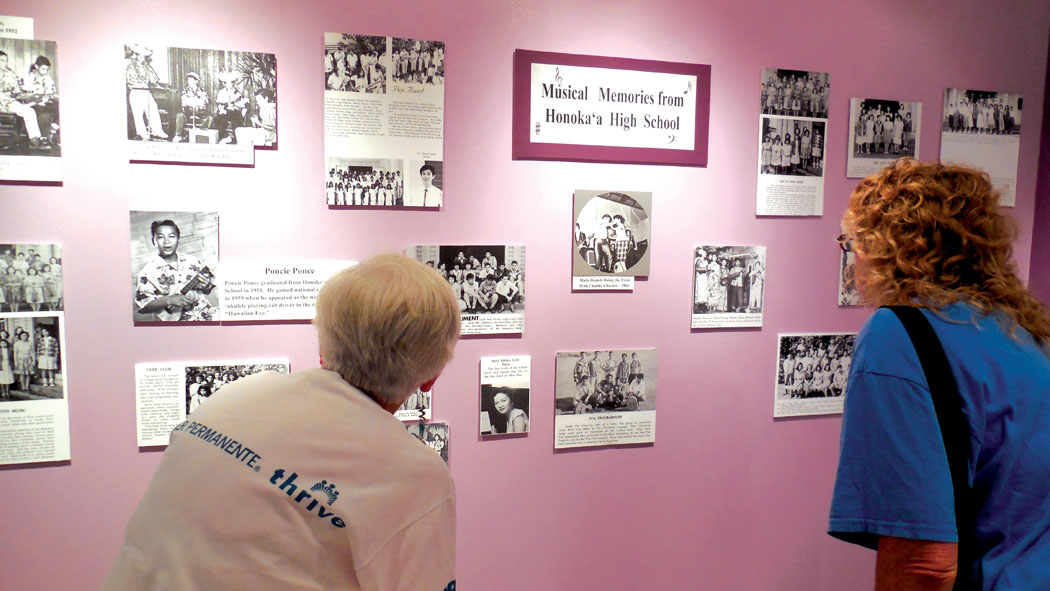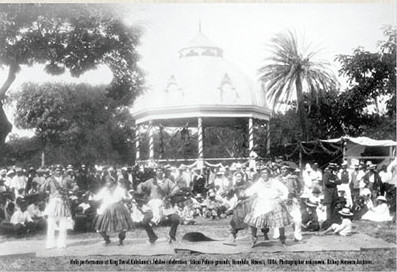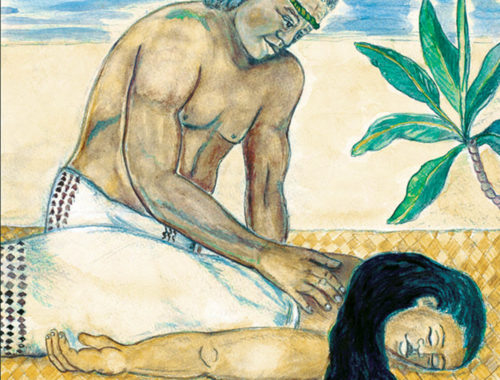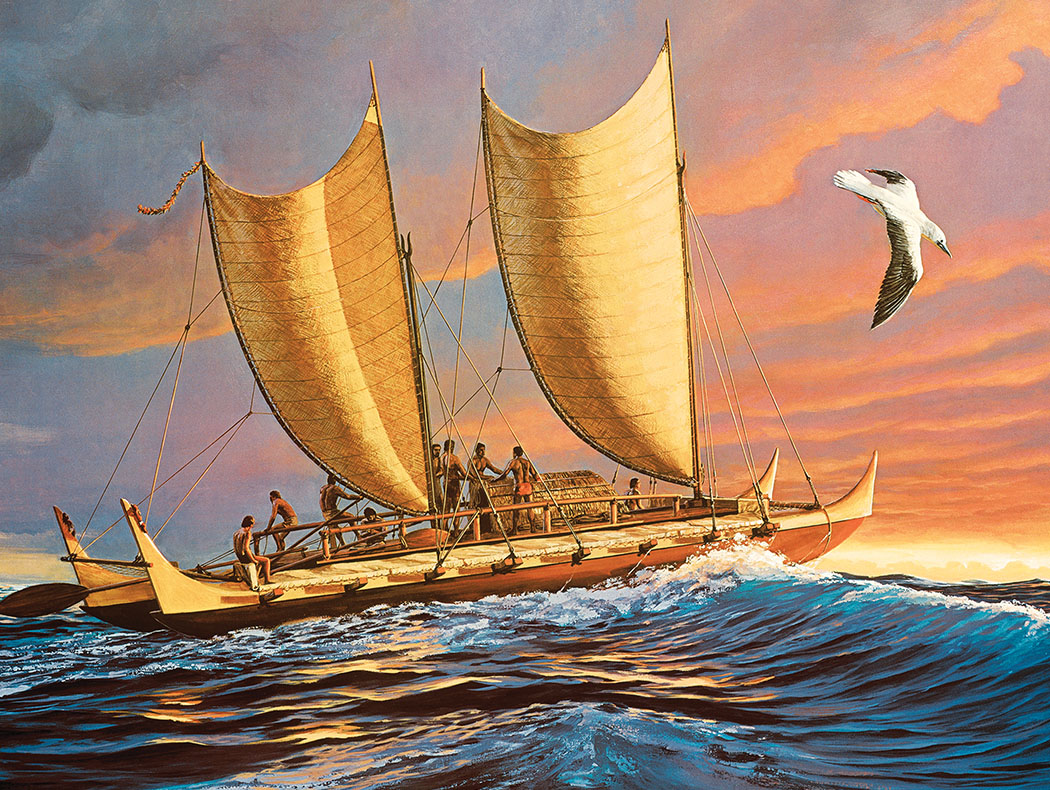
Kūpuna Talk Story: Herb Kawainui Kāne, Father of the Hawaiian Renaissance
 By Keith Nealy
By Keith Nealy
As a filmmaker and storyteller, I have been blessed with the gift of sharing the mana‘o (knowledge) of more than 60 of Hawai‘i’s most revered kūpuna in spirited conversations exploring the cultural legacy they carry in their memory. Each conversation has been a journey back in time into the world they inhabited, through their eyes, and expressed in their words. This Kūpuna Talk Story series begins with excerpts from a conversation with Herb Kāne in 2004 during the filming of The Magic of Makali‘i.
Herb: “Sailing across the channels, especially the ‘Alenuihāhā Channel between Maui and Hawai‘i in the middle of the night, we encountered one squall after another and 12-foot swells. It was so dark you could see phosphorescence breaking on the top of the waves. During initial sea trials of the Hōkūle‘a, that channel was the hairiest experience of it all. I felt that the canoe was going to get us through okay. As you start crossing the channel the swells start heaping up because they reflect off the cliffs on both Maui and Hawai‘i. And so these reflective swells meet and they suddenly pile up and crash, and it can get a bit exciting. We got through that okay, and by daybreak we were just screaming off of South Kohala, still running with the wind on our port quarter. And I would swear that we were doing 17 knots—and that’s after we had bailed out [laughs], checking every few minutes for water that got into the hulls and bailing pretty constantly. Yeah, it was pretty exciting.”
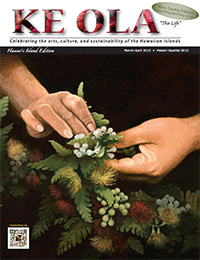
Having this conversation with Herb Kāne, I felt like a little kid talking with Superman as Herb had been my hero since I was a boy sailing off East Hampton, Long Island, imagining I was a Polynesian voyager. Many people know Herb Kawainui Kāne as the premiere Hawaiian artist famous for his paintings of ka po‘e kahiko (the people of old) and his sculptures and books on Hawaiian cultural history. Not many know him as the catalyst responsible for the Hawaiian cultural renaissance in the 1970s, continuing to this very day.
Nainoa Thompson, navigator of the Hōkūle‘a, says Kāne was “the visionary, the dreamer, and he was the architect and the engineer. He’s the one who carried the burden of building and constructing and sailing Hōkūle‘a. When you look at Herb’s legacy, it is transforming Hawai‘i’s society because he brought pride and culture and inspiration back through the canoe…He is the father of the Hawaiian Renaissance.”
Keith: Herb, what were some of the things that might’ve gone through your mind when you were sailing…thinking about what it must have been like centuries ago?
Herb: I felt a closeness to the old people. At night—the first time steering to Kaua‘i from Hawai‘i—I knew the stars and I took dead aim on them. It was a dark night with no moon. I steered on the stars and I thought, Well, here I am using the same stars that some people used a long, long time ago, and we’ll see what happens now when the sun comes up. Well, the sun came up and we were off Kīlauea Lighthouse on Kaua‘i—exactly where I hoped we’d be.
Keith: What did it do for you in terms of you connecting to your culture? How did that make you feel?
Herb: I felt very connected. I saw this not just for myself, but happily with all the guys and gals who trained on the canoe. That they had this feeling of connection to the past in a very positive way, very spiritual way, but without getting into discussing it, without getting into trying to explain it, knowing that there are some things that defy explanation in words.
Keith: You know what it’s like being out in rough seas, being pushed to the limit. And I just keep thinking that the ancient voyagers must have had—through their oneness with nature— a different sense of fear or of courage, of being more comfortable with it. Have you thought about that at all?
Herb: They had a different worldview than ours. To them it was their own world, it was their only world. We can see the difference in attitude between the ocean people—the Polynesians, the Micronesians—and people who lived on continents and were much more reluctant to leave those continents and sail away from the comforting presence of those continents, fearing they might even fall off the edge of the world.
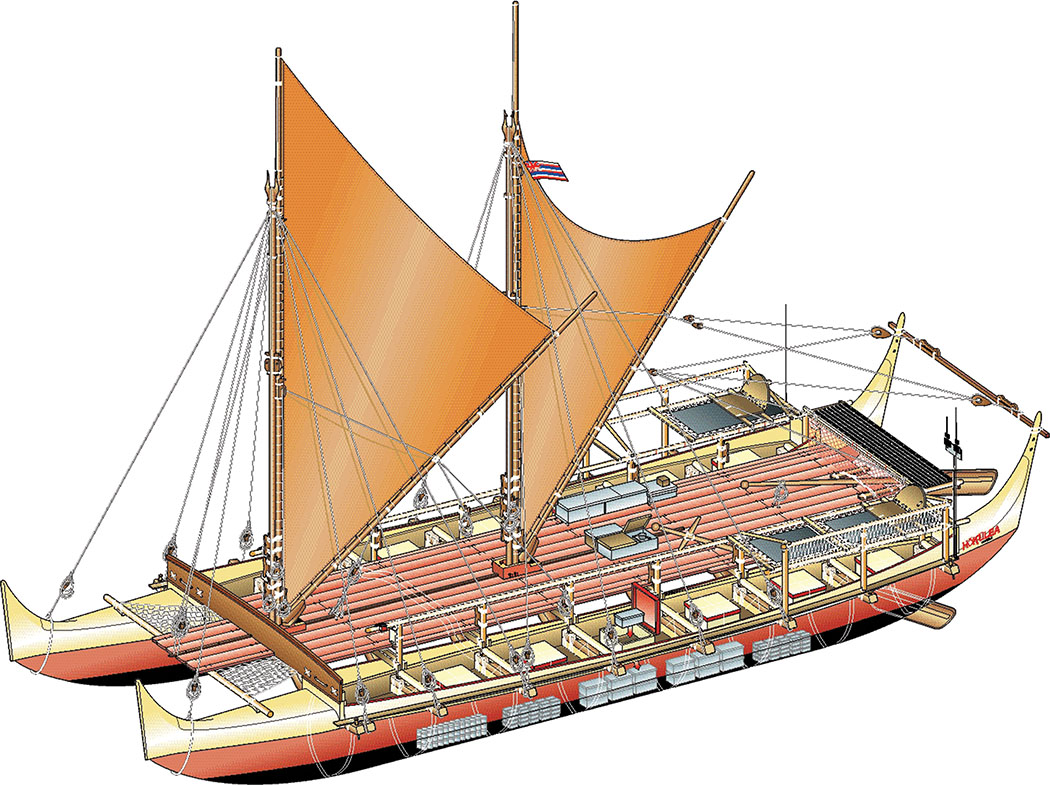
Keith: What was the reason that you created the Hōkūle‘a?
Herb: Ben Finney and I and Tommy Holmes were the three collaborators who created the Polynesian Voyaging Society and Hōkūle‘a. Tommy was a canoe paddler. For him, it was strictly adventure. For Ben, he was chairman of the anthropology division at the University of Hawai‘i and it was an opportunity to answer some of the scientific questions. One of the reasons we created the Hōkūle‘a was to test the performance of a wa‘a kaulua (an ocean-going double-hulled voyaging canoe) and come to some conclusion as to the worldwide debate about Polynesian maritime capabilities.
But there was another overriding reason from my point of view, which was not the scientific reason, but the cultural reason. I saw the canoe as the central object of the entire culture. It lay at the heart of the culture. It lay at the center of the cultural web. And everything about the culture was somehow—even if peripherally—related to the canoe. And my interest at that time was to rebuild the central object to see if that would inspire our renaissance.
You see, no culture can exist without its objects. If a cultural loses an integral object that’s cultural disintegration. And people may retain a memory of it, which erodes and becomes distorted with time and eventually fades and then it’s forgotten. But bring that object back and you can effectuate the regeneration of the culture.
Keith: Do you think that some of the values the ancient voyagers had have been lost over time?
Herb: Yes, they were lost because we don’t live with that intimacy with nature any longer. We don’t have the respect for nature that they did. They had an idea that one had to live in harmony with nature; that everything had to be kept in balance, in lōkahi. Theirs was a universe of opposites—in which everything had to be balanced by an opposite. There cannot be any heat without cold. You cannot identify light if you don’t know darkness. There is an eternal opposition between masculine and feminine. But these opposites created a constructive tension throughout the entire fabric of the universe and it was thus planned by the original spirits. And one did everything one could to preserve that harmonious balance to live successfully. If you disrupted that, bad things could happen.
Keith: What were your experiences with master navigator Mau Piulug from Micronesia?
Herb: [smiles happily] Mau is a friend. Ben Finney suggested bringing Mau in because he is of a culture in which navigation has not been interrupted. They still build canoes the same way that they did 500 years ago. They still sail in the same way they did 500 years ago and these are excellent canoes. In fact, I’ve been researching the type of canoe that they sail and I’ve done a painting of that type of canoe. I want to carry on with that, to do some explanatory drawings of how they can be put together. It’s a very complicated system of struts and pieces that are all locked together, and I could not get hold of any photographs. So, I had a model made on Satawal.
Keith: What do you think about Mau’s capability for wayfinding navigation?
Herb: Excellent—absolutely flawless—within his sphere of geography. He is the only living master who can read the stars, the swells, the sealife, and be at one with the natural and spiritual forces to find his way in the vast Pacific Ocean. He’s amazing.
Keith: When I interviewed Mau, he told me a fascinating story about when they were on their way to Tahiti on Hōkūle‘a’s maiden voyage. While he was resting down below, he was still tracking the swells. I had heard a rumor that he was the only person alive who could track five different swells at the same time. And he told me that he came up from below because they had turned completely 180° around. It was a total cloudy dark night, so navigation was almost impossible, and he told the captain ‘you’re going back to Honolulu.’ Finally the clouds broke and they were able to see some stars, and sure enough they were making a slow wide turn and were headed back to Honolulu.
Herb laughs.
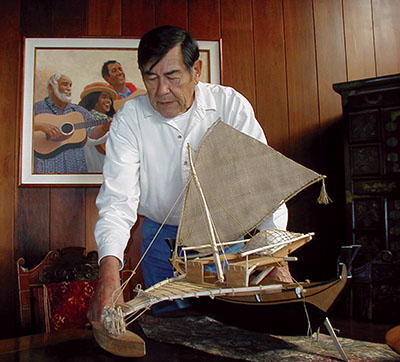
Keith: A number of years ago, I was sailing on Makali‘i to Maui across the ‘Alenuihāhā Channel at night and had a similar experience as you had with the 12-foot erratic swells. I had always been very impressed with the skills of the women sailors who have been sailing Makali‘i, but that night the women were particularly impressive. Was that always the case?
Herb: That was an idea we had from the very beginning. And we had some problems with that, with some old-timers [who] said that women didn’t go on canoes. Well, how the hell did they get here if they didn’t come on canoes? [laughs]. Yes, we had some problems with that, but we just didn’t pay any attention to some of those remarks. Today, there are many great women sailors.
Keith: Was building the Hōkūle‘a also an essential way for you to reconnect to your own Hawaiian cultural roots?
Herb: Yes, I think it was. And my dad did tell me, he said, “You’ve done alright, much to my surprise. I never thought you’d make it as an artist, but you’ve done okay. So I’d really appreciate if you go back to Hawai‘i and do something for the people.”
Keith: I’ve talked to many kūpuna who feel the need to come together to move into the future—saying Hawaiians and Westerners need to put aside a lot of the problems to i mua (move forward) by building a bridge between the cultures. In your book Voyagers (1991, 2nd edition 2006), you talked about the Polynesian world and the Judeo-Christian world where you describe the Western world developing technologically and the Polynesian world being more one with nature. It seems that as a world society, what we need is the best of both worlds to avoid destroying our planet. How do we build that bridge to get us to work together to move forward? Is that something you think about?
Herb: Yes, I do think about it. Politeness is very important. Dignity. Restraint. One of the problems noticeably in my own life span is the multiplicity of choices. And that means two things. It means that we have wants that are becoming needs. And we have a dangerous consumerism and demand for goods that is rapidly stripping our planet of its natural resources. So I think the lesson that we can learn from the Neolithic people that were here in 1778—who had an affluent culture—is that there’s something that they had that we are missing. And that we have to—through some kind of discipline—go on a quest to reacquire some of those values. And not just for Hawaiians or Polynesians or Southwest American Indians, but for everybody in the world.
• • •
In June of 2013 the Hōkūle‘a and its support vessel, Hikianalia, will embark on a four-year World Wide Voyage to carry the message that ancient wisdom can and will inspire contemporary solutions toward a healthy and sustainable future for our planet. The quest Herb dreamed about many years ago is finally becoming a reality.
Herb Kāne passed March 8, 2011, on the 36th anniversary of the launch of the Hōkūle‘a, leaving a vast legacy. I think most people would agree that Herb’s dad would be very proud of him. ❖
Hokulea II image provided by Fine Balance Imaging Studios, info@fbistudios.com
Herb Kāne fine art prints available at: HerbKaneHawaii.com, GratitudeGallery.com
Contact writer Keith Nealy: KeithNealy.com
Kūpuna Talk Story ©2013 Keith Nealy Productions
